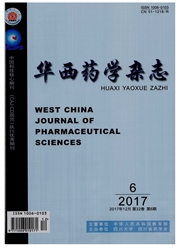

 中文摘要:
中文摘要:
目的采用饱和溶液法和粉末吸湿法测定临界相对湿度(CRH)的等效性;探讨样品/环境面积比对两种方法的影响,并考察铺粉厚度、粒径、干燥程度和吸湿时间对粉末吸湿法的影响。方法分别用两种方法测得11种药物和盐在25℃时的CRH值,利用双侧t检验对结果进行分析;以氯化镁为例,对样品/环境面积比进行考察,以氯化钠为例,对铺粉厚度、粒径、干燥程度和吸湿时间进行考察。结果与结论两种方法测定CRH值无显著性差异;样品/环境面积比小于0.5时,两种方法所测CRH值与文献值无显著性差异,铺粉厚度对测得的CRH值有显著性影响,粒径、干燥程度和吸湿时间影响药物的吸湿百分率,但对测得的CRH值无显著性影响。
 英文摘要:
英文摘要:
OBJECTIVE To validate the equivalence of saturated solution method and powder moisture absorption method on the determination of critical relative humidity (CRH) ; to explore the influence of the area ratio of sample ( the sum of the bottom areas of weighting bottles used for setting sample) to environment ( the area of saturated solution at the bottom of desiccator) on the two methods; to explore the influence of the thickness of powder layer, panicle size, drying degree of powder and moisture absorption time on the powder moisture absorption method. METHODS The CRH of eleven drugs and salts were determined with saturated solution method and powder moisture absorption method at 25 ℃, magnesium chloride were selected and sodium chloride were selected to observe the influence of the area ratio of sample to environment, thickness of powder layer, panicle size, drying degree of powder and moisture absorption time. RESULTS & CONCLUSION The CRH data determined by the two methods have no significant difference. The determined data and the reported data have no significant difference when the area ratio of sample to environment is less than 0.5. The CRH determined by powder moisture absorption method is influenced by the thickness of powder layer. The humidity absorption percent is influenced by particle size, drying degree of powder and moisture absorption time, but the CRH is not.
 同期刊论文项目
同期刊论文项目
 同项目期刊论文
同项目期刊论文
 期刊信息
期刊信息
